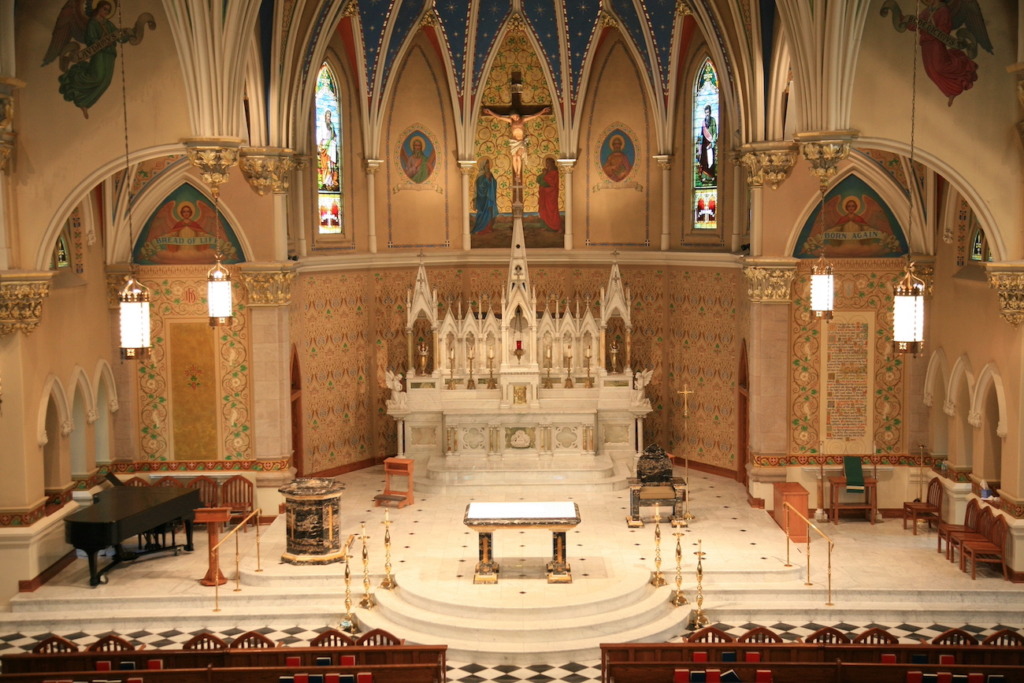Like anyone at Mass, the interior of St. Andrew in Roanoke has been wearing a mask, as water leaks, peeling paint and candle smoke marred the decorative details on the walls and ceiling of the historic American Gothic structure.
Now, the layer of dust, grime and soot accumulated over 45 years is gone.
“It’s just beautiful. The whole inside is brightened up,” parishioner Rena Dombrosky said just before daily Mass one day last month.
“It’s a beautiful church in the first place, and it’s just renewed and looks so much better than it was,” said parishioner Butch Steahley outside the nearly 120-year-old building. “It’s got some age on it, so this has tremendously improved it.”
The inside work was the third and final step in a seven-year restoration project that included replacing the steeples and the slate roof and repairing the exterior brickwork. The total cost was about $7.7 million — all paid with donations from parishioners and others in the area.
“They’re wonderful,” said Father Kevin Segerblom, pastor. “The people are just very generous.”
And patient.
From just after Easter this year to mid-August, steel scaffolding ran from the floor to the ceiling, about 65 feet high, so “artisans could touch every surface of the interior of the church without having to get on a ladder,” Father Segerblom said. “Michelangelo would have wept tears of joy and gratitude had he had scaffolding like this.”
The painter of the Sistine Chapel might have loved it, but parishioners had to work their way around poles and braces to find a pew at Mass and a path to Communion.
“If this place had been shut down, we could have been done it in half the length of time,” said facilities maintenance coordinator Wayne Gould. “But it’s a working church, and even during the interior renovation we designed the scaffolding so you could have church.”
The point man for the restoration, Gould said he expected to just do maintenance when he was hired several years ago. But he and other parish leaders came to realize that the landmark yellow brick church overlooking downtown Roanoke was in trouble.
Living off water and mortar, termites infested the steeple towers. To stop leaks, the roof slates had been caulked together; they work best when they shift in response to heating and cooling. The lightning protection system was outdated, and the last time the interior had been cleaned and painted was 1975.
“We didn’t change a lot,” Gould said. “We put some ‘wow’ factors in there in a couple of places.”
For example, the lower walls were redone to imitate marble. A new baptismal font, made in Italy, is ready to be put in place this week. It has a stainless-steel liner inside the marble to prevent leaks. Water also damaged the blue dome painted with stars under the apse, but now those details pop.
Restoration projects sometimes turn up messages from the past. Gould said they did find that one worker had signed a roof slate. A man also put his name and the date on some stone carvings at the top of the church. Gould said he’s left a little memento that some future restorer may find: four 2021 coins that he glued to the back of a brass plate above a decorative pendant.

That might be the only spare change that didn’t make it into the fundraising campaign, set up and managed by Lynch Development Associates in New York.
“It was too large a campaign to do ourselves,” said Father Segerblom. “We probably could have done it, but it was a massive undertaking, so we knew we would be more successful if we brought in a professional fundraising company. Their approach to it was one we really agreed with, and we got working.”
“I was always surprised at what came in after the campaigns,” Gould said.
He had a breakfast meeting recently with a friend he’d done business with for 40 years, who said he had done a great job at St. Andrew and then asked what else he needed. Gould mentioned the new font and a new reconciliation room; his friend wrote a check for $50,000.
“This is a guy who goes to a different church because of location, but he just relishes when he comes here, like this is where he wants to be,” he said.
Historic building tax credits will help with the cost of the restoration.
A non-Catholic, Gould says he understands the reasons the people support these projects.
Beautiful liturgies are celebrated in lots of places, Father Segerblom said, including St. Patrick in Scott County, a “beautiful little log cabin” where he was pastor before coming to St. Andrew. “
We should give our very best to God,” he said. “A place where we worship God, where we as Catholics recognize Christ is present in the sacramental liturgy of the Eucharist, where heaven and Earth meet, we should be our very best, the best that we’re about to manage.”
Gould also learned last month that St. Andrew will be receiving a top award from the Roanoke Valley Preservation Foundation for showing good stewardship in preserving an iconic landmark.
“Good architecture is living art,” Father Segerblom said. “Sacred architecture moves people to think about, to want to worship, God, to think of heavenly things as well as being grateful for the things that we have here on Earth.”
The priest is looking forward to Nov. 30, the feast of St. Andrew, when Bishop Barry C. Knestout will preside at a rededication ceremony.
“The first time that I processed in the church after all the work was done was just a marvelous feeling,” Father Segerblom recalled. “I thought, ‘This generation has been asked to do this major restoration work. Our turn came, and we’ve done it, and it looks gorgeous.’”
Anyone coming to that celebration, though, will still need a mask.

